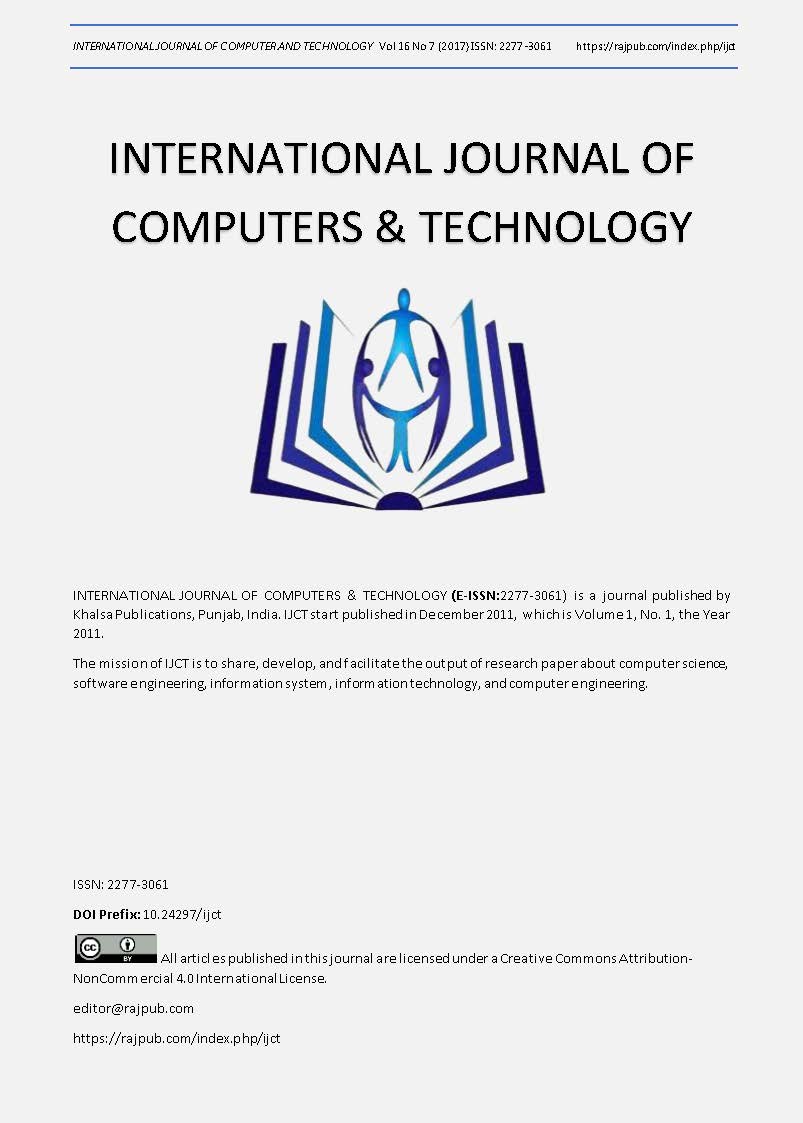Smallest Univalue Segment Assimilating Nucleus approach to Brain MRI Image Segmentation using Fuzzy C-Means and Fuzzy K-Means Algorithms
DOI:
https://doi.org/10.24297/ijct.v16i7.6170Keywords:
Brain magnetic resonance imaging, cluster validity functions, fuzzy C-means, fuzzy K-means, segmentationAbstract
Image segmentation still remains an important task in image processing and analysis. Sequel to any segmentation process, preprocessing activities carried out on the images have a great effect on the accuracy of the segmentation task. This paper therefore laid emphasis on the preprocessing stage of brain Magnetic Resonance Imaging (MRI) images Smallest Univalue Segment Assimilating Nucleus (SUSAN) and bias field correction algorithms. Subsequently, brain tissue extraction tool was employed in extracting non-brain tissues from the brain image. Afterwards, Fuzzy K-Means (FKM) and Fuzzy C-Means (FCM) segmentation algorithms were employed for segmenting brain MRI images acquired from four different MRI databases into their White Matter (WM), Gray Matter (GM) and Cerebrospinal Fluid (CSF) constituents. Evaluation metrics such as cluster validity functions using partition coefficients and partition entropy; area error metrics such as false positive, true positive, true negative and false negative (FN); similarity index, sensitivity and specificity were used to evaluate the performance of both techniques. A comparative analysis of the experimental results revealed that in most instances, FKM segmentation technique is preferable to FCM segmentation technique for brain MRI segmentation task.
Downloads
References
2. Ivana Despotović, Bart Goossens, and Wilfried Philips (2015), “MRI Segmentation of the Human Brain: Challenges, Methods, and Applicationsâ€, Computational and Mathematical Methods in Medicine, Volume 2015, pp 1-23
3. S. Ramathilagam, R. Pandiyarajan, A. Sathya, R. Devi and S.R. Kannan (2011), “Modified fuzzy c-means algorithm for segmentation of T1–T2-weighted brain MRIâ€, Journal of Computational and Applied Mathematics, Vol. 23, No. 5, Pp. 1578–1586
4. Mahipal Singh Choudhry and Rajiv Kapoor (2016), “Performance Analysis of Fuzzy C-Means Clustering Methods for MRI Image Segmentationâ€, Procedia Computer Science, Vol. 89, pp. 749 – 758
5. J. Quintanilla-Dominguez, B. Ojeda-Magaña, M.G. Cortina-Januchs, R. Ruelas, A. Vega-Corona, D. Andina (2011), “Image segmentation by fuzzy and possibilistic clustering algorithms for the identification of microcalcifications, Scientia Iranica, Vol. 18, issue 3, pp. 580–589.
6. Ezhil E. Nithila and S.S. Kumar (2016), “Segmentation of lung nodule in CT data using active contour model and Fuzzy C-mean clustering, Alexandria Engineering Journal
7. E.A. Zanaty (2012), “Determining the number of clusters for kernelized fuzzy C-means algorithms for automatic medical image segmentationâ€, Egyptian Informatics Journal, Vol. 13, pp. 39–58
8. Viswanathan P (2015), “Fuzzy C means Detection of Leukemia based on Morphological Contour Segmentationâ€, Procedia Computer Science, vol. 58, pp. 84 – 90
9. Mutasem K. Alsmadi (2016), “A hybrid Fuzzy C-Means and Neutrosophic for jaw lesions segmentation, Ain Shams Engineering Journal, http://dx.doi.org/10.1016/j.asej.2016.03.016
10. S. M. Aqil Burney and Humera Tariq (2014), “K-Means Cluster Analysis for Image Segmentationâ€, International Journal of Computer Applications, Vol.96, No.4, Pp. 0975 – 8887.
11. Ajay Kumar and Shishir Kumar (2016), “Color Image Segmentation via Improved K-Means Algorithmâ€, International Journal of Advanced Computer Science and Applications, Vol. 7, No. 3, Pp. 46-53.
12. B. Simhachalam and G. Ganesan (2016), “Performance comparison of fuzzy and non-fuzzy classification methodsâ€, Egyptian Informatics Journal, Vol. 17, pp. 183–188.
13. CHIH-TANG CHANG, JIM Z. C. LAI and MU-DER JENG (), “A Fuzzy K-means Clustering Algorithm Using Cluster Center Displacementâ€, Journal of Information Science and Engineering, Vol. 27, 995-1009.
14. D. Liu and F. Kubala (2004), “Online speaker clustering,†in Proceedings of IEEE Conference on Acoustic, Speech, and Signal Processing, Vol. 1, 2004, pp. 333-336.
15. Manish Sarkar and Tze-Yun Leong (2001), “Fuzzy K-means Clustering with Missing Valuesâ€, In: Proceedings of American Medical Informatics Association, (AMIA), pp. 588–592.
16. Soumi Ghosh and Sanjay Kumar Dubey (2013), “Comparative Analysis of K-Means and Fuzzy C-Means Algorithmsâ€, International Journal of Advanced Computer Science and Applications, Vol. 4, No.4, pp. 35-39.
17. Alsmadi M. K. (2015), “MRI brain segmentation using a hybrid artificial bee colony algorithm with fuzzy-C mean algorithmâ€, Journal of Applied Sciences, Vol. 15, pp. 100–109.
18. Real brain MRI dataset downloaded from http://mr.usc.edu/download/data/ under the CC Attribution-Noncommercial-Share Alike 3.0 License sponsored by NSF grant CCF-1350563, accessed on 10th Nov., 2016.
19. Lichman, M. (2013), “UCI Machine Learning Repositoryâ€, [http://archive.ics.uci.edu/ml]. Irvine, CA: University of California, School of Information and Computer Science. Accessed on 12th Nov., 2016.
20. S.M. Smith and J.M. Brady (1997), “SUSAN - a new approach to low level image processingâ€, International Journal of Computer Vision, vol. 23, No. 1, Pp. 45-78
21. Mohamed N. Ahmed, Sameh M. Yamany, Nevin Mohamed, Aly A. Farag and Thomas Moriarty (2002), “A Modified Fuzzy C-Means Algorithm for Bias Field Estimation and Segmentation of MRI Dataâ€, IEEE Transactions On Medical Imaging, Vol. 21, No. 3, Pp. 193-199.
22. C. M. Collins, W. Liu, W. Schreiber, Q. X. Yang, and M. B. Smith (2005), “Central brightening due to constructive interference with, without, and despite dielectric resonance,†Journal of Magnetic Resonance Imaging, vol. 21, no. 2, pp. 192–196
23. Synthetic brain MRI dataset downloaded from http://brainweb.bic.mni.mcgill.ca/cgi/brainweb1,accessed on 11th August, 2016
24. Manually labeled brain MRI images datasets downloaded from Internet Brain Segmentation Repository (IBSR)- https://www.nitrc.org/projects/ibsr accessed on 11th August, 2016
25. Bullitt E, Zeng D, Gerig G, Aylward S, Joshi S, Smith JK, Lin W, Ewend MG (2005) Vessel tortuosity and brain tumor malignancy: A blinded study. Academic Radiology 12:1232-1240









